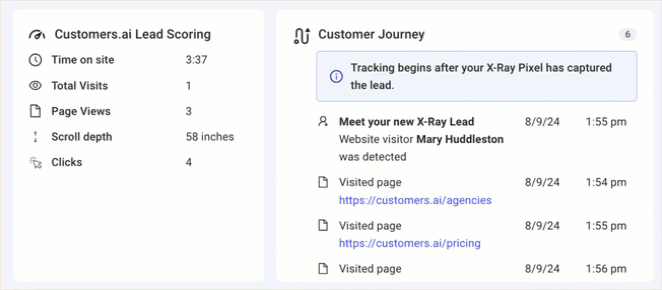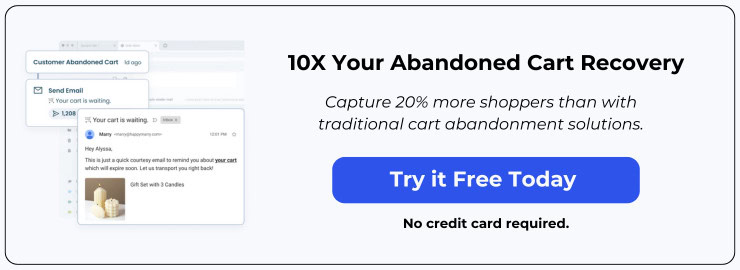Does your website feel like a black box?
You invest effort into optimizing the design, copy, and user experience, but have no clue how visitors actually interact with your site.
That’s where website visitor tracking comes in.
By understanding visitor behavior, you can unlock serious conversion rate optimization gains.
In this post, we’ll explore how visitor tracking data illuminates the customer journey and pinpoints areas for optimization. You’ll learn what visitor tracking metrics to focus on and tips for leveraging that intel to boost conversions.
Let’s dive in!
Visitor Tracking 101
Website visitor tracking involves collecting data on how users navigate and interact with your website.
This includes details like:
- which pages they visit
- how they arrived,
- heir geographic location
- the device/browser they use
- how long they stay on each page,
- where they click, scroll and hover, and more.
By aggregating and analyzing this data, you get a panoramic view into the real customer experience on your site.
No more guessing what’s working and what’s not – visitor tracking provides a fact-based picture of how people truly use your site.
Optimizing the Full Funnel with Visitor Tracking
One key advantage is that visitor tracking provides insights across the entire marketing funnel. This allows you to identify and remedy friction points that hinder conversions at every stage.
At the top of the funnel, visitor tracking shows you how users discover your site and which channels drive the most engaged traffic. You can then double down on your top acquisition sources.

In the funnel’s middle, you’ll see which pages have high bounce/exit rates and where visitors get stuck or lost. With this intel, you can streamline navigation, improve content quality, and remove conversion roadblocks.
Finally, visitor tracking illuminates the bottom of the funnel conversion pathways. You can map out the most common routes to purchase and tweak those funnels for maximum conversions.
By connecting the dots between visitor behavior and conversions, you can holistically optimize the customer journey from awareness to purchase.
Key Visitor Tracking Metrics to Monitor
With visitor tracking, there’s a wealth of data to sift through. But which metrics should you focus on for conversion rate optimization (CRO)?
Here are some of the most important:
- Traffic sources – Identify your top referral channels for engaged visitors
- Click maps – See where users click most often to spot missed CTAs
- Scroll maps – Are visitors consuming your content or bouncing early?
- Session recordings – Watch real visitor sessions to experience friction firsthand
- Bounce rate – Which pages have high bounce rates that need improving?
- Conversion funnels – Map out the most common pathways to purchase
By zeroing in on these metrics, you’ll quickly pinpoint areas for optimization and start boosting conversions.
Leveraging Visitor Tracking for CRO
So how can you put visitor tracking data into action for CRO? Here are some tips:
Top of Funnel: At the top of the funnel, focus on driving more traffic from your highest-converting channels identified in the traffic sources report. Optimize your messaging and ads for those top sources.
Mid-Funnel: In the middle of the funnel, use click and scroll maps to spot areas of visitor confusion or disengagement on key pages. Update the content and design to reduce bounces.
Bottom of Funnel: For the bottom of the funnel, watch session recordings to identify sticking points in the conversion process. See where users hesitate or drop off, and streamline those pathways.
And at every stage, leverage conversion funnel visualizations. Identify your highest-converting pathways and double down on optimizing those routes.
Key Takeaways
Website visitor tracking is a game-changer for conversion rate optimization. By understanding how real users navigate and interact with your site, you can:
- Identify and remove friction points across the entire funnel
- Optimize for your top acquisition channels
- Streamline conversion pathways
- Improve content to reduce bounces
- Leverage data-driven insights, not guesswork
While there’s a lot of data involved, focusing on metrics like traffic sources, click/scroll maps, recordings, and funnel visualizations will supercharge your CRO efforts.
The bottom line?
Visitor tracking takes the blinders off and allows you to truly optimize the customer experience.
By seeing your site through your users’ eyes, you can craft a journey that maximizes conversions at every step.
FAQs
-
What is website visitor tracking?
Website visitor tracking involves collecting data on how users navigate and interact with your website, such as pages visited, traffic sources, and user behavior. -
How does visitor tracking help with conversion rate optimization?
Visitor tracking data illuminates the full customer journey, allowing you to identify and remove friction points that prevent conversions across the entire funnel. -
What are the key visitor tracking metrics for conversion optimization?
Focus on metrics like traffic sources, click/scroll maps, session recordings, bounce rates, and conversion funnel visualizations to pinpoint areas for improvement. -
How can visitor tracking data optimize the top of the funnel?
Visitor tracking shows you which channels drive the most engaged traffic, allowing you to double down on top acquisition sources. -
How does visitor tracking optimize the middle of the funnel?
In the middle of the funnel, visitor tracking reveals pages with high bounce/exit rates and where visitors get stuck, so you can streamline navigation and content. -
How can visitor tracking improve the bottom of the conversion funnel?
Visitor tracking maps out the most common conversion pathways, enabling you to tweak those funnels for maximum conversions. -
What visitor tracking tools are available?
Popular visitor tracking tools include heatmaps, session recordings, funnel visualization software, and comprehensive analytics platforms. -
How do you implement visitor tracking on your website?
Most visitor tracking tools can be easily implemented by adding a tracking code snippet to your website. -
Are there any privacy concerns with visitor tracking?
While visitor tracking collects user data, most tools are GDPR/CCPA compliant and allow you to anonymize data or obtain user consent. -
How frequently should you analyze visitor tracking data?
For best results, regularly review visitor tracking data (weekly or monthly) to quickly identify trends and opportunities for optimization.
